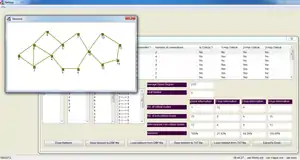LASCNN algorithm
In graph theory, LASCNN is a Localized Algorithm for Segregation of Critical/Non-critical Nodes[1] The algorithm works on the principle of distinguishing between critical and non-critical nodes for network connectivity based on limited topology information.[2] The algorithm finds the critical nodes with partial information within a few hops.[3]
This algorithm can distinguish the critical nodes of the network with high precision, indeed, accuracy can reach 100% when identifying non-critical nodes.[4] The performance of LASCNN is scalable and quite competitive compared to other schemes.[5]
Pseudocode
The LASCNN algorithm establishes a k-hop neighbor list and a duplicate free pair wise connection list based on k-hop information. If the neighbors stay connected then the node is non-critical.[6][7]
Function LASCNN(MAHSN)
For ∀ A ∈ MAHSN
If (A->ConnList.getSize() == 1) then
A->SetNonCritical() = LEAF
Else
Continue = TRUE
While (Continue == TRUE)
Continue = FALSE
For ∀ ActiveConn ∈ ConnList
If (A∉ActiveConn) then
If (A->ConnNeighbors.getSize() == 0)
A->ConnNeighbors.add(ActiveConn)
Continue = TRUE
else
If (ActiveConn ∩ ConnNeighbors == TRUE)
ActiveConn ∪ ConnNeighbors
Continue = TRUE
Endif
Endif
Endif
End For
End While
Endif
If (A->ConnNeighbors.getSize() < A->Neighbors.getSize())
A->SetCritical() = TRUE
else
A->SetNonCritical() = INTERMEDIATE
Endif
End For
End Function
Implementation

The Critical Nodes application is a Free Open-Source implementation for the LASCNN algorithm. The application was developed in 2013 using Programming Without Coding Technology software.[8]
See also
References
- Muhammad Imran, Mohamed A. Alnuem, Mahmoud S. Fayed, and Atif Alamri. "Localized algorithm for segregation of critical/non-critical nodes in mobile ad hoc and sensor networks." Procedia Computer Science 19 (2013): 1167–1172.
- N. Javaid, A. Ahmad, M. Imran, A. A. Alhamed and M. Guizani, "BIETX: A new quality link metric for Static Wireless Multi-hop Networks," 2016 International Wireless Communications and Mobile Computing Conference (IWCMC), Paphos, 2016, pp. 784–789, doi:10.1109/IWCMC.2016.7577157.
- Kim, Beom-Su, Kyong Hoon Kim, and Ki-Il Kim. "A survey on mobility support in wireless body area networks." Sensors 17, no. 4 (2017): 797.
- Zhang, Y.; Zhang, Z.; Zhang, B. A Novel Hybrid Optimization Scheme on Connectivity Restoration Processes for Large Scale Industrial Wireless Sensor and Actuator Networks. Processes 2019, 7, 939.
- Kasali, F. A., Y. A. Adekunle, A. A. Izang, O. Ebiesuwa, and O. Otusile. "Evaluation of Formal Method Usage amongst Babcock University Students in Nigeria." Evaluation 5, no. 1 (2016).
- G. Sugithaetal., International Journal of Advanced Engineering Technology E-ISSN 0976-3945
- Mohammed Alnuem, Nazir Ahmad Zafar, Muhammad Imran, Sana Ullah, and Mahmoud S. Fayed. "Formal specification and validation of a localized algorithm for segregation of critical/noncritical nodes in MAHSNs." International Journal of Distributed Sensor Networks 10, no. 6 (2014): 140973
- Fayed, Al-Qurishi, Alamri, Aldariseh (2017) PWCT: visual language for IoT and cloud computing applications and systems, ACM